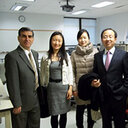Cholinergic anti-inflammatory pathway inhibits neointimal hyperplasia by suppressing inflammation and oxidative stress.
الكلمات الدالة
نبذة مختصرة
Neointimal hyperplasia as a consequence of vascular injury is aggravated by inflammatory reaction and oxidative stress. The α7 nicotinic acetylcholine receptor (α7nAChR) is a orchestrator of cholinergic anti-inflammatory pathway (CAP), which refers to a physiological neuro-immune mechanism that restricts inflammation. Here, we investigated the potential role of CAP in neointimal hyperplasia using α7nAChR knockout (KO) mice. Male α7nAChR-KO mice and their wild-type control mice (WT) were subjected to wire injury in left common carotid artery. At 4 weeks post injury, the injured aortae were isolated for examination. The neointimal hyperplasia after wire injury was significantly aggravated in α7nAChR-KO mice compared with WT mice. The α7nAChR-KO mice had increased collagen contents and vascular smooth muscle cells (VSMCs) amount. Moreover, the inflammation was significantly enhanced in the neointima of α7nAChR-KO mice relative to WT mice, evidenced by the increased expression of tumor necrosis factor-α/interleukin-1β, and macrophage infiltration. Meanwhile, the chemokines chemokine (C-C motif) ligand 2 and chemokine (CXC motif) ligand 2 expression was also augmented in the neointima of α7nAChR-KO mice compared with WT mice. Additionally, the depletion of superoxide dismutase (SOD) and reduced glutathione (GSH), and the upregulation of 3-nitrotyrosine, malondialdehyde and myeloperoxidase were more pronounced in neointima of α7nAChR-KO mice compared with WT mice. Accordingly, the protein expression of NADPH oxidase 1 (Nox1), Nox2 and Nox4, was also higher in neointima of α7nAChR-KO mice compared with WT mice. Finally, pharmacologically activation of CAP with a selective α7nAChR agonist PNU-282987, significantly reduced neointima formation, arterial inflammation and oxidative stress after vascular injury in C57BL/6 mice. In conclusion, our results demonstrate that α7nAChR-mediated CAP is a neuro-physiological mechanism that inhibits neointima formation after vascular injury via suppressing arterial inflammation and oxidative stress. Further, these results imply that targeting α7nAChR may be a promising interventional strategy for in-stent stenosis.


